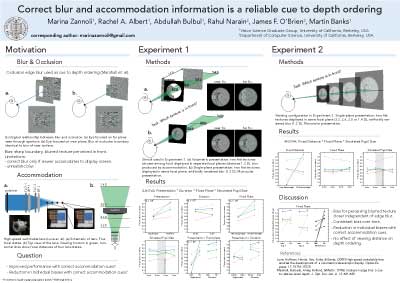Correct blur and accommodation information is a reliable cue to depth ordering.

Download Paper
Download Bibtex
Authors
- Marina Zannoli
- Rachel A. Albert
- Abdullah Bulbul
- Rahul Narain
- James F. O'Brien
- Martin Banks
Abstract
Marshall et al. (1996) showed that blur could in principle also be used to determine depth ordering of two surfaces across an occlusion boundary from the correlation between the boundary’s blur and the blur of the two surfaces. They tested this experimentally by presenting stimuli on a conventional display and manipulating rendered blur. This approximates the retinal image formed by surfaces at different depths and an occlusion boundary, but only when the viewer accommodates to the display screen. Accommodation to other distances creates incorrect blur. Viewers' judgments of depth ordering were inconsistent: they generally judged the sharper surface as nearer than the blurrier one regardless of boundary blur. We asked if more consistent performance occurs when accommodation has the appropriate effect on the retinal image. We used a volumetric display to present nearly correct focus cues. Images were displayed on four image planes at focal distances from 1.4-3.2 diopters. Viewers indicated the nearer of two textured surfaces separated by a sinusoidal boundary. The stimuli were presented either on one plane as in previous experiments or on two planes (separated either by 0.6 or by 1.2 diopters) such that focus cues are nearly correct. Viewers first fixated and accommodated to a cross on one of the planes. The stimulus was then presented either for 200ms, too short for accommodative change, or for 4s, allowing accommodative change. Responses were much more accurate in the two-plane condition than in the single-plane condition, which shows that appropriate blur can be used to determine depth ordering across an occlusion boundary. Responses were also more accurate with the longer presentations, which shows that accommodation aids depth-order determination. Thus, correct blur and accommodation information across an occlusion boundary yields more accurate depth-ordering judgments than indicated by previous work.
Citation
Marina Zannoli, Rachel A. Albert, Abdullah Bulbul, Rahul Narain, James F. O'Brien, , and Martin Banks. "Correct blur and accommodation information is a reliable cue to depth ordering.". Journal of Vision, 14(10):138, August 2014.
Supplemental Material









